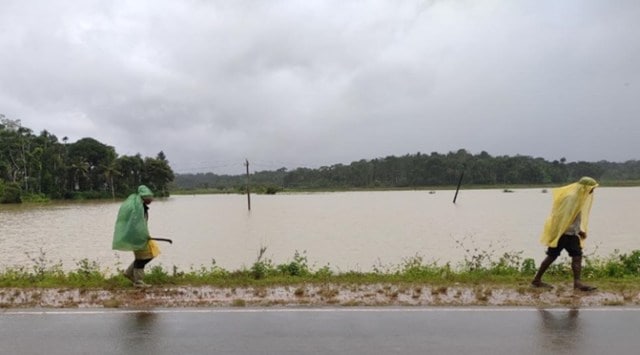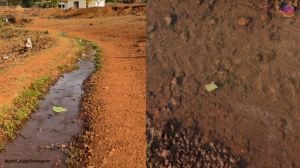- India
- International
Over 2.5 lakh hectares crop area damaged in Maharashtra; cane growers less hit
Even in 2019 when the cane-growing belt of the western Maharashtra had faced days of submergence, barring a slight dip of 10 per cent, farmers in that belt did not report much loss of yield.
 Under the PMFBY, mid-season adversity is a trigger for weather conditions such as extreme rainfall and temperature which, once pressed, make farmers eligible for insurance pay-outs under PMFBY. (File)
Under the PMFBY, mid-season adversity is a trigger for weather conditions such as extreme rainfall and temperature which, once pressed, make farmers eligible for insurance pay-outs under PMFBY. (File)The recent spate of rains and floods, which ravaged Maharashtra over the past few days, has seen over 2.5 lakh hectares of crop area bearing the brunt of it. While crops like maize, soybean, groundnut vegetables, paddy and sugarcane have suffered losses, cane growers might not face losses to the extent faced by others.
Even in 2019 when the cane-growing belt of the western Maharashtra had faced days of submergence, barring a slight dip of 10 per cent, farmers in that belt did not report much loss of yield.
Over the past few days, many parts of Maharashtra have faced torrential rains, which have led to more than 100 deaths across the state. Floods and landslides have brought about untold miseries and seen the rescue operations being launched. Konkan, Kolhapur, Sangli, Satara, Parbhani, Akola, Washim, Nagpur and Wardha are some of the districts which have reported damage to crop.
 By far, the cane capital of Kolhapur has seen the maximum damage with 50,000 hectares of cropped area reportedly destroyed. Sangli, Pune and Satara have reported around 4,000 hectares each damaged, while Washim, Akola, Nagpur and few other districts in Vidharbha have reported 30,000 hectares of damage.
By far, the cane capital of Kolhapur has seen the maximum damage with 50,000 hectares of cropped area reportedly destroyed. Sangli, Pune and Satara have reported around 4,000 hectares each damaged, while Washim, Akola, Nagpur and few other districts in Vidharbha have reported 30,000 hectares of damage.
Konkan and a few districts of Marathwada make up for the rest. The final figure is expected to rise as more flood waters recede, allowing officials to reach remote areas that have been cut off so far.

Sugar industry experts said unlike crops like soybean, groundnut and vegetables, chances of complete crop loss is minimal in cane. Vijay Autade, an industry expert, explained this was due to the physiology of the crop, which allows it to survive extremes in terms of drought and floods better than any other crop. “Even if the top portion of the crop is submerged in flood waters for 10 day, the crop can regenerate and revive,” he said.
In 2019, when flash floods had affected western Maharashtra, Kolhapur, Sangli and Satara had reported crop damage over 2.16 lakh hectares; Kolhapur (1.05) lakh hectares, Sangli (73,000 hectares) and Satara (38,000 hectares).
Over 60 per cent of this was under cane, of which 60,000-70,000 hectares have seen the crop completely submerged. However, contrary to expectations, yield and recovery in the area were not much affected.
Thus for the season of 2019-20, mills in Kolhapur crushed 123.50 lakh tonnes of cane and produced 15.15 lakh tonnes of sugar with an average recovery of 12.30 per cent. Similarly, the district of Sangli had seen crushing of 67.23 lakh tonnes of cane and production of 8.31lakh tonnes of sugar.
Fields in Shirol and Hatkanangale taluka of Kolhapur had seen the maximum inundation given the presence of rivers like Vedganga, Panchganga and others. But mills in the area had reported almost normal crushing.
Autade said unlike in 2019, the floods have come in July so the crop would have ample time till October to revive and grow. “The floodwaters bring with them very fertile soil which helps regeneration of the sub soil. The industry would not feel much loss due to this,” he said.
Click here to join Express Pune WhatsApp channel and get a curated list of our stories
Apr 26: Latest News
- 01
- 02
- 03
- 04
- 05








































